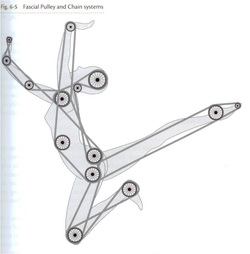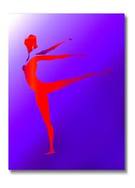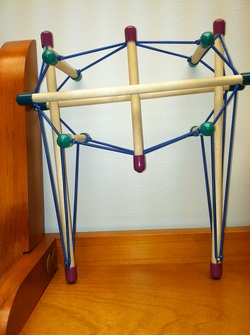
As I discussed in the last blog the Pelvic Girdle is the center of all activity in movement. It is a limited source and because of its makeup both structurally and physiologically, movement will be slow and very methodical. It is more of a supporting structure and needs to move mainly to support the vertebral column and position itself to allow proper movement of the spine and hip joint. In balancing the Pelvic Girdle I was able to bring about support but soon learned that much more was needed to insure proper movement from that support point. My studies and research took me down many avenues and the picture above really did prove the point that we are interconnected and as in any mechanical system there needs to be a balance.
While learning movement it was impressed on me that individuals do not have tight hamstrings, but restricted movement in the back. During this time I was also studying Tensegrity or the ability to move in proper tension. It was this discovery of the pull/push system of movement that explained more on the principals of movement in the pelvic girdle.
The Pelvis has the ability to shift according to necessity and how it shifts will often explain the resultant discomfort that many experience. One example is the hip joint, although a circular joint it moves in an elliptical or oval format. What the Pelvis needs to do is alter its posture to accommodate the precision of movement in the joint itself. When it is not able many malady's will take place, Sciatic Nerve discomfort because of inappropriate tension on the Piriformis muscle, deep hip pain that radiates into the groin region, low back discomfort which is sometimes caused by the shifting laterally of the lumbar vertebrae, and forms of functional scoliosis.
I originally classified these movements as lateral rotation of the full girdle, {an opening or closing of one side of the pelvis}, obliquity or one side higher than the other, and forward or backward tilting of the Pelvis on one side or both. I was able to develop release techniques to bring about a natural tension to the Pelvic Girdle. It was this natural tension that helped develop a structural correct posture but was still somewhat limiting in natural movement.
Balancing the movement between the three major bones of the Pelvis and the structure above and below became the challenge that was made into the opportunity. The Tensegrity of the connections to the Pelvis is where we went next in our journey to find the natural balance of structure and how it correlated to movement.
As we continue our journey into Muscle Release Therapy, MRTh® we will discuss next the interconnection of the low extremities to the Pelvis.
a Reason to HOPE!
Dennis



 RSS Feed
RSS Feed
